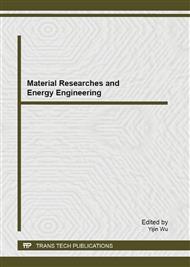[1]
ANSYS Engineering Analysis System. Theoretical Manual for ANSYS, Swanson Analysis Systems, Inc., Houston Pensylvania.
Google Scholar
[2]
VSL Post-Tensioning solutions. VSL International Ltd., company leaflets, (2009).
Google Scholar
[3]
MS3A Wind Turbine Generator. Specification for Steel Tower. MS3A-6014, Rev. 2, Wind Energy Group Limited, (1992).
Google Scholar
[4]
ČSN 73 0032 Calculation of building structures loaded by dynamic effect of machines (in Czech), (1977).
Google Scholar
[5]
ČSN EN 1992-1-1 (73 1201) Eurocode 2: Design of concrete structures - Part 1-1: General rules and rules for buildings, ČNI 11/(2006).
Google Scholar
[6]
R. Cajka, Prestressed Concrete Tower for WEG 400 Wind Turbine, Design Study (in Czech), Ostrava 01/(1994).
Google Scholar
[7]
R. Cajka, Soil – structure interaction in case of exceptional mining and flood actions, COST 12 – Final Conference Proceedings, University of Innsbruck, Austria, ISBN 04 1536 609 7, 20th – 22nd January (2005).
DOI: 10.1201/9780203970843.ch41
Google Scholar
[8]
R. Cajka, P. Manasek, Building Structures in Danger of Flooding. IABSE Conference New Delhi, India, (2005).
DOI: 10.2749/222137805796272296
Google Scholar
[9]
R. Cajka, Accuracy of Stress Analysis Using Numerical Integration of Elastic Half-Space (2013).
Google Scholar
[10]
C. Chen, P. Pan, S. Zhang, Q. Meng, Dynamic analysis and evaluation of wind turbine towers (2012), Applied Mechanics and Materials, 193-194, pp.639-642.
DOI: 10.4028/www.scientific.net/amm.193-194.639
Google Scholar
[11]
L. Jiang, X. Xu, Z. Di, Research on contact characteristics of the foundation for wind turbine generator system (2011), Applied Mechanics and Materials, 63-64, pp.633-636.
DOI: 10.4028/www.scientific.net/amm.63-64.633
Google Scholar
[12]
E. Juhásová, J. Hájek, Concrete Stacks and Cooling Towers Loaded by Dynamic Impacts (in Czech), VEDA Bratislava 1990, 302 s.
Google Scholar
[13]
J. Kala, V. Salajka, P. Hradil, Response of water tower on wind induced vibration considering interaction of fluid and structure (2013), Applied Mechanics and Materials, 284-287, pp.1269-1272.
DOI: 10.4028/www.scientific.net/amm.284-287.1269
Google Scholar
[14]
J. Kala, V. Salajka, P. Hradil, Calculation of timber outlook tower with influence of behavior of steel-timber, connection (2012), Advanced Materials Research, 428, pp.165-168.
DOI: 10.4028/www.scientific.net/amr.428.165
Google Scholar
[15]
M. Krejsa, P. Janas, R. Cajka, Using DOProC Method in Structural Reliability Assessment (2013).
Google Scholar
[16]
B. Li, Z. Han, C. Gao, Experiment research on mechanical behaviour for latticed concrete-filled steel tubular tower with three limbs (2012), Advanced Materials Research, 368-373, pp.58-61.
DOI: 10.4028/www.scientific.net/amr.368-373.58
Google Scholar
[17]
Y. Li, W. Qu, B. Wang, Y. Wang, B. Ji, Three-dimensional numerical simulation of downburst wind occurred in Wuhan (2011), Advanced Materials Research, 243-249, pp.5037-5040.
DOI: 10.4028/www.scientific.net/amr.243-249.5037
Google Scholar
[18]
S. Xi, W. Yin-Guang, L. Heng-Zhou, D. Jian-Xin, Stability analysis and numerical simulation of the conical tower of the wind turbine (2013), Applied Mechanics and Materials, 249-250, pp.759-764.
DOI: 10.4028/www.scientific.net/amm.249-250.759
Google Scholar
[19]
S. Yamada, M. Araya, M. Fukuda, Y. Iwasaki, Statistical time series analysis of crack movements at Bayon main tower, Cambodia (2010), Advanced Materials Research, 133-134, pp.397-402.
DOI: 10.4028/www.scientific.net/amr.133-134.397
Google Scholar
[20]
J. Wang, X. Xu, D. Zhang, J. Tian, Finite element method mechanical characteristics analysis of tower foundation for wind turbine generator system (2012), Advanced Materials Research, 499, pp.327-330.
DOI: 10.4028/www.scientific.net/amr.499.327
Google Scholar
[21]
H. Wei, Y.J. Cheng, Z.Y. Peng, H.J. Wang, Finite element analysis for the wind resistance of the tower of wind turbine (2011), Advanced Materials Research, 189-193, pp.1718-1721.
DOI: 10.4028/www.scientific.net/amr.189-193.1718
Google Scholar
[22]
Y. Wen, The study on force behaviour of concrete filled steel tube lattice wind turbine tower with three limb columns (2012), Applied Mechanics and Materials, 178-181, pp.179-183.
DOI: 10.4028/www.scientific.net/amm.178-181.179
Google Scholar
[23]
R. Zhu, Z. Zheng, Y. Liu, J. Shen, Y. Xiao, D. Jiang, J. Chen, Finite element analysis for MW wind turbine tower (2012), Applied Mechanics and Materials, 130-134, pp.124-127.
DOI: 10.4028/www.scientific.net/amm.130-134.124
Google Scholar


